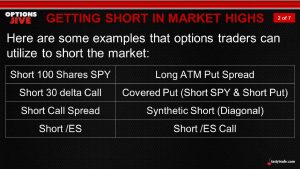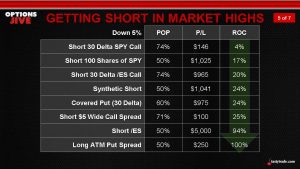So You Want Short the Market—Here’s How
The bulls have been in charge since March of 2020, but if sentiment changes, it’s important to know how to short the market—as a standalone position or a hedge.

The breadth and duration of the current rally has been so impressive that a short bet in the market is starting to feel blasphemous.
But as seen on Black Friday, nothing lasts forever. And while “buying the dip” has worked extremely well since March 2020, there’s no guarantee that the same approach will work in 2022.
Along those lines, investors and traders may want to familiarize themselves with how to get short just in case the fundamental and technical indicators go south for the winter.
In terms of betting against the market at large, one choice for investors and traders is to deploy a bearish position in a major stock index using an ETF, an option, or a futures product.
For example, one might use a short position in the primary ETF of the S&P 500, known as the SPDR S&P 500 ETF Trust (SPY). Alternatively, in the futures universe, the E-mini S&P 500 Future (/ES) is a common go-to for many investors and traders.
Within an index, an investor/trader has a wide range of choices for getting short the market using the underlying or associated options, as illustrated in the graphic below.

As shown above, the choices range from a simple short position in SPY or /ES, all the way to a derivatives-based position, such as a short call, a covered put, or a short call spread. And each of these positions has its own associated risk profile—meaning that the potential P/L of each respective position will vary.
The best way to understand the potential behavior of a position in the market is to mock trade it, as well as to execute an associated scenario analysis. The mock trading allows one to better understand the daily risk profile of the position, while the scenario analysis can help investors and traders get a better feel for the potential maximum gains/losses of a specific position.
The fact that options have set expirations is another important consideration when deploying a directional position using such instruments. With options it’s entirely possible a market participant would get the position correct, but get the timing wrong.
tastytrade previously conducted a scenario analysis on some of the aforementioned short positions, and the results help illustrate the potential gains from each respective position, assuming the S&P 500 corrected by 5%.

The positions with lower associated probability of profit (POP) produced higher returns on capital (ROC), on average. This is logical because more risk (i.e. lower probability of success) generally produces more reward.
Along those same lines, the positions with a higher likelihood of success generally produced smaller returns.
Investors and traders also need to consider the reverse scenario—the associated losses for each position—when deploying bearish, directional positions such as these. That’s one reason mock trading and scenario analysis is so important when trading new, or unfamiliar, positions.
Of course, another choice to get short the market—or an individual security/asset—is to simply buy a put. The maximum loss for a long put is limited to the premium paid to enter the position, which is often nominal. But long puts generally have low associated probabilities of profit, as they are essentially longshots from a statistical standpoint.
One should also keep in mind the volatility products when considering “bearish” positions on the market.
Broad market indices such as the S&P 500 traditionally share a strong, inverse relationship with volatility metrics such as the CBOE Volatility Index (VIX). That means an investor/trader looking to benefit from a correction in the S&P 500 might also theoretically get long the VIX, or the iPath Series B S&P 500 VIX Short-Term Futures ETN (VXX).
As an ETN, the VXX trades like a stock—meaning market participants can buy it, short it, or trade options on it. The VIX can only be traded via options or futures.
On Black Friday this year, when the stock market suffered a sharp correction, volatility products like VIX and VXX spiked higher, producing outsized gains for long players. In this case, those “long” positions in VIX and VXX were essentially bearish plays on the market.
To learn more about “getting short” in the market, readers are encouraged to review this previous installment of Options Jive on the tastytrade financial network. Additionally, this past episode of Market Measures explores short hedging approaches.
Alternatively, readers looking for new bullish ideas in the market may want to review this new installment of Options Trading Concepts Live.
For timely updates on everything moving the financial markets, readers can also tune into TASTYTRADE LIVE—weekdays from 7 a.m. to 4 p.m. CST—at their convenience.
Sage Anderson is a pseudonym. He’s an experienced trader of equity derivatives and has managed volatility-based portfolios as a former prop trading firm employee. He’s not an employee of Luckbox, tastytrade or any affiliated companies. Readers can direct questions about this blog or other trading-related subjects, to support@luckboxmagazine.com.




















